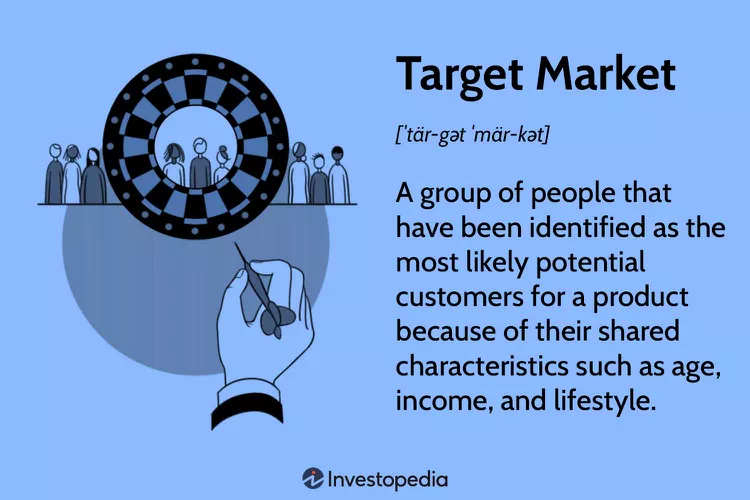The Complete Guide to Creating a Target Market Strategy
Imagine this: You have a powerful tool at your disposal, a tool that helps you connect with customers who are not only interested in what you have to offer but are also eager to buy. Wouldn’t you want this tool?
Well, that is what a Target Market Strategy would do for you. In this blog post, we’re going to be talking about how you can create a Target Market Strategy that will supercharge your business and ensure you improve ROI. Let’s Begin!
Understanding Target Markets
Imagine you’re running a lemonade stand. You know that not everyone passing by will buy your lemonade. Some people might not like lemonade at all, while others prefer other drinks.
But there’s a special group of people who absolutely love lemonade, especially on a hot day. These are the folks you want to target with your advertising, this is what a target market is all about.
What is a Target Market
A target market is a group of people that have been identified as the most likely potential customers for a product because of their shared characteristics, such as age, income, and lifestyle.

From the example, the group of lemonade enthusiasts has something in common – maybe they’re mostly adults, live in a warm climate, and often visit parks.
When you zoom in even closer, you find the perfect customer – someone who’s already thirsty for lemonade. You don’t have to convince them; they’re already interested. You just need to make sure they see your lemonade stand. That’s what a target market is all about – finding and reaching the people most likely to buy what you’re selling.
Now that we have seen what the target market is, what is a target market strategy?
What is a Target Market Strategy?
A Target Market Strategy is a game plan for businesses used to reach their target market. The aim is to focus on only the target audience instead of trying to talk to everyone in the marketplace.
What is a Target Market Strategy?
Let’s explore the examples of specific target markets.
Examples of Specific Target Markets
Examples of specific target markets are simply groups of people who either buy a product already or are likely to buy it based on certain things about them. Here are examples of common target markets.

Tech-Savvy Millennials:
Description: Individuals aged 25-40 who are highly proficient in using technology and are early adopters of new gadgets and apps.
Products/Services:
- Smartphones, mobile apps, tech accessories, online streaming services, etc.

Fitness Enthusiasts:
Description: People of all ages who prioritize health and fitness, including gym-goers, runners, and yoga practitioners.
Products/Services:
- Fitness equipment, activewear, nutritional supplements, fitness apps.

Pet Owners:
Description: People who own pets, such as dogs or cats, and prioritize their well-being.
Products/Services:
- Pet food, grooming services, pet insurance, pet-friendly accommodations.

Small Business Owners:
Description: Entrepreneurs and small business owners who need various tools and services to run their businesses
Products/Services:
- Business software, marketing services, office supplies, accounting software.

Working Parents:
Description: Mothers and fathers with full-time jobs who are looking for convenience and family-friendly products
Products/Services:
- Childcare services, meal delivery kits, and family-oriented vacations.
Basic Demographics:
This means things like how old they are, if they’re married, how educated they are, or what job they have. If a business knows its customers are mostly young professionals, it will advertise software products online where young professionals hang out.
Geographic Area:
Sometimes businesses want to sell in a specific place, like a certain country or part of a city. They focus their marketing there to get new customers.
Consumer Behavior:
This is about how people buy things. For example, if someone puts stuff in an online shopping cart but doesn’t buy it right away, a business might target them with ads to encourage them to finish the purchase.
Beliefs and Values:
Some people care a lot about specific things like religion or social causes. Businesses can aim their marketing at these values to connect with people who care about the same things.
By knowing who you want to reach, you can pick the best ways to reach them. If it’s about where they live, you can use ads online that show up in their area.
If it’s about what they like, you can use ads that match their interests or the websites they visit. It’s all about finding the right way to get your business in front of the people who are most likely to be interested.
7 Steps to Defining Your Target Market Strategy
Here are the steps you can take to create your own target market strategy to effectively plan for sales growth:
1. Identify your current consumer base
The first step to engaging a target market is to determine the scope of your existing consumer base. Once you know the traits and habits of your current customers, you can decide whether to pursue new ways to reach customers in that market or find other groups to target as potential customers. Startup companies do this by examining their competitors’ target markets.
2. Evaluate target markets for viability
Before you spend time shaping marketing campaigns to reach a chosen market, decide if this group will be worth the effort. Use metrics like competetors’ market share to project the amount of business you expect to gain from the target market. The goal of choosing a target market is to decide which segment can bring the most value to your business. Once you analyze the opportunities in a particular market segment, you can begin to plan the best ways to reach that audience.
3. Determine the best marketing strategy
There are several ways a business can determine and reach a target market. Here are the key strategies companies typically use:
- Mass marketing (undifferentiated): This strategy is used only when a business decides to target everyone as a possible market. Choosing the entire consumer marketplace as a target can be a challenging goal, but it can also be effective for reaching as many people as possible. Companies who use this strategy typically sell goods or services that everyone needs, such as food, basic hygiene products or furniture.
- Segmented marketing (differentiated): Using consumer segments to market to a target audience is a traditional strategy. In this strategy, businesses identify key groups or segments of consumers and tailor their marketing to reach these audiences. This strategy allows businesses to concentrate their efforts on multiple target markets at once while still finding specific groups that best fit their consumer profile.
- Concentrated (niche marketing): In a niche market strategy, business professionals break market segments into more detailed concentrations of consumer groups. Businesses who choose this strategy often narrow their focus to gain more market share over their competition within a specific customer base. Niche marketing methods often combine consumer traits to create highly specialized audiences.
- Micromarketing: A micromarketing strategy is the most concentrated form of target marketing. In this method, businesses concentrate on marketing to individuals within a target audience. This strategy often involves personalized marketing content based on a user’s purchasing choices and preferences.
4. Create a client profile
To help make decisions for marketing efforts, companies create sample customers based on their target market. Client profiles are formed with detailed characteristics of a fictionalized but realistic potential or existing customer.
By using software to compose a sample consumer or simply discussing a typical client in a meeting and recording the team’s choices, marketing professionals are able to reference this profile in a variety of ways. Marketing teams use sample client profiles for presentations, data analysis models and ad campaign prototypes. Sample client profiles can also help you visualize future customers.
Related: Target Demographics: What They Are and How To Identify Them
5. Analyze your data
To find out if your strategy is successful, choose certain metrics to analyze. This can help you determine how effectively you are reaching your target markets. Look for key performance indicators (KPIs) that your team decides on prior to launching your strategy. Data analysis will also give you an idea of ways you can implement changes to your marketing plan to better reach your chosen market. Use marketing software tools that help quantify complex consumer behaviors like website traffic, social media engagement and advertising conversions.
Read more: 18 Key Performance Indicators To Improve Your Marketing
Showcase your skills with help from a resume expert
Tips for creating a target market strategy
Here are some ideas to help you strategize ways to reach your target market:
Use a variety of tools to reach your target market
Try to reach your potential customers in a variety of ways to ensure the most exposure for your brand. Here are some ideas for ways you can gain attention from consumers:
- Content marketing: This includes tools like blogging, video content, infographics and ebooks. Content marketing presents shareable information to a target audience.
- Email marketing: When potential customers visit your website, create an opportunity for them to sign up for email communications. Sending an email newsletter with relevant product information, discounts and special events can establish your position as an expert and create brand loyalty.
- SEO: Search engine optimization uses keywords relevant to a target market to increase website traffic. Once you identify the keywords your target market uses to search for a product or service, you can optimize your website to reflect these keywords through different content.
- Online advertising: Banner ads are a key way to advertise online. Including banner advertising means your target market is more likely to see an ad related to your product or service during their web browsing.
- Traditional advertising: Radio ads, television commercials and direct mail can also be effective tools for reaching a target audience as a supplement to other methods.
Related: Target Market Analysis: What It Is and How To Make One
Focus on social media that fits your brand
Different social media platforms uniquely benefit specific businesses or product types. Your brand may not need to use all types of social media to reach your audience. Instead, focus on the platforms that fit your brand’s communication style and work best to promote your product or services.
Target market examples
Let’s take a look at some major brands that have killed it in their target market analysis. They have found their ideal customers far and wide by being super specific and targeted.
1. Nike Target Market
Nike sells apparel, equipment, shoes, and accessories to athletes and people who play sports. Their products are good quality and last for a long time, driving the price range up enough so that only people with disposable income can afford to purchase their products.
But that’s not the only detail about their target audience.
They specifically target young aspiring athletes and runners, two groups of people who rely on motivation to continue pushing themselves beyond their normal limitations.
And we can see this play out in most of Nike’s marketing campaigns, where they create motivational ads that can move viewers to tears.
Read more: Nike’s Brilliant Marketing Strategy – Why You Should Be (Just) Doing it Too
2. Netflix Target Market
A lesson to be learned from Netflix has less to do with its actual target market, which is constantly evolving, and more to do with their approach to reaching their target market.
They continuously conduct research on their audience and meticulously provide them with what they want. From mail-in DVD rentals to a behemoth online streaming service, Netflix has notoriously leaned into its audience and pivoted when needed.
And in doing so, they let word-of-mouth marketing fuel their sales.
Read more: How Netflix Achieved 137 Million Subscribers – Through Word-of-Mouth
3. Lego Target Market
Lego is a household brand across the entire world and for good reason: though children are the users of their products, parents are the ones buying them.
So Lego built its entire marketing strategy around appeasing the parents. Not only that but Lego also partnered with brands, movies, and video games with cult-like followings to further secure its place in the fantasy world that many children escape to.
By understanding their target audience and potential barriers to purchase, Lego turned itself into a multi-billion dollar business.
4. Vans Target Market
Vans has made its empire by appealing to misfits and rebels. Like Netflix, the company learned to lean into what worked and who wanted their products rather than trying to strictly stick to their original vision. By allowing the target market to guide them, they found extreme success with their loyal customers.
Read more: 5 Ways Vans Found Their Target Market of Rebels & Misfits
5. Dior Target Market
Dior is an exclusive brand that sets itself apart with its high price tag and innovative design. By setting itself apart with such a niche brand, they very easily found their very niche audience.
But it wasn’t their unique value proposition that made them super successful. It was the way they marketed themselves as exclusive that did the trick.
By understanding what kinds of people would appreciate their products, they made their marketing campaigns to match.
Read more: How Dior Dominated And Achieved a Valuation of $42.7 Billion
6. Coachella Target Market
Coachella is a music festival that hosts artists of all genres, proving to be the festival where everyone is welcome.
And the hipsters, who pride themselves in being a unique carbon copy of everything that is cool, ate that offering right up. As the primary market for the Coachella festival, hipsters paved the way for the Coachella marketing campaign.
The brand started pairing up with other brands that hipsters regularly interact with, such as H&M and YouTube, to further solidify their place in the hearts of hipster millennials, eventually making themselves a multi-million dollar annual festival.
7. Glossier
Glossier is a beauty brand that has gained a cult following thanks to their minimalistic branding and focus on natural beauty. Glossier’s target market is millennials who are looking for a natural, effortless beauty routine. Their products are designed to be easy to use and enhance natural beauty rather than conceal it.
8. Dollar Shave Club
Dollar Shave Club is a subscription service that delivers high-quality razors and grooming products to your doorstep. Their target market is men who are looking for a convenient and affordable solution for their grooming needs. They use humor in their marketing campaigns to appeal to their target market and have gained a loyal following as a result.
9. Fabletics
Fabletics is a subscription-based athletic wear brand that was co-founded by actress Kate Hudson. Their target market is women who are looking for stylish and functional athletic wear that doesn’t break the bank. They use social media influencers to reach their target market and have built a strong community around their brand.
10. Warby Parker
Warby Parker is an eyewear brand that offers stylish, affordable glasses and sunglasses. Their target market is millennials who are looking for fashionable eyewear at a reasonable price. They use social media and word-of-mouth marketing to reach their target market and have built a strong brand identity as a result.
11. Chewy
Chewy is an eCommerce brand that offers pet food, toys, and accessories. Their target market is pet owners who are looking for convenience and a wide selection of products. They offer free 1-2 day shipping on orders over $49 and have a customer service team that is available 24/7 to help pet owners with any questions or concerns.
12. Casper
Casper is a mattress-in-a-box company that disrupted the traditional mattress industry. Their target market is people who are looking for a convenient and affordable way to buy a mattress. They offer a 100-night trial period and free shipping and returns, which has helped them gain a loyal following and a strong brand identity.
13. REI
REI is an outdoor gear and apparel retailer that encourages people to get outside and explore. Their target market is outdoor enthusiasts who are looking for high-quality gear and apparel. They have a co-op membership program that offers exclusive discounts and access to events and have built a strong brand identity around their mission to inspire people to get outside.






